A Worm Eats in Brooklyn
A couple weeks ago, I left work promptly at 5pm to head to the Jefferson Market branch of the New York Public Library near 10th St. in Greenwich Village. There, along with over 40 other people, I learned how a person in New York can buy worms, keep them in a container in their apartment, and feed them food scraps . The morning of the class, which I'd stumbled upon at the web site of the Lower East Side Ecology Center , I called the library wondering if, in fact, this class really existed. I had emailed and called the Ecology Center, and nobody replied. I began to have doubts: who would actually attend a workshop about worms? The librarians, even, had no idea what I was talking about, and I felt sheepish asking: it's not something normal, like asking when the book club meets. Nevertheless, I slipped into the church-like building off 6th Avenue (which is actually a former courthouse) and found my way to the auditorium, waiting to be turned away.
There was a sizable line outside the auditorium door, so I assumed that the class I was looking for must be someplace else in the library. In a basement somewhere, a musty classroom. "Are you here for the worms?" I asked a couple women who had also just wandered up. They looked at me for a second, hesitating. "Yeah." So we were in the right place. We made it to the door, where I looked in and saw a stage with a large plastic bin on a table, a sign-in sheet with flyers--and a room full of people. Corporate-looking people in suits, casual hippie types leftover from 60s Greenwich Village, older people, younger people, a cop, three or four children, some tweedy professorials--all here to learn about indoor worm composting. I get proud in moments like these that I live in New York, where no matter how small the interest, a crazy cross-section of people will somehow find each other and have meetings.
What is worm composting, and what's the purpose? Worm composting is an environmentally smart, compact way of reducing ones waste and in turn creating nutritious "vermicompost," a nutrient-rich substance that makes plants grow. Essentially, it's this: you feed the worms your leftover vegetable food scraps; they eat it, and what's left is compost. That "black gold" can eventually used for houseplants, gardening in an urban community garden, or simply, as the presenters at my workshop offered, for sprinkling on a city tree outside your apartment. It may seem kind of crunchy and extreme, and it probably is--but somehow the symbiotic human-worm relationship that develops is strangely comforting. It's hard to resist a solution that takes something you were planning to throw away and turns it into a useful commodity. For the urban apartment dweller, it's another step in the direction of that strange pull to realize rural pleasures.
It all started with my friends Matt and Dave, who, besides being the salt of the earth, cook astoundingly good enchiladas on Sunday mornings for all their friends, and brew them good coffee, all for free (but they've been on hiatus for the last month or two--leaving a hole on my soul. Hey guys, please start it up again!). They're a very unassuming pair, but secretly they're also into amazing culinary projects that I've never even dreamed of, like having multiple sourdough cultures living in their apartment. One Coffee & Enchiladas I was invited upstairs to visit their "pet worms."
The worms live under the bed, in a clear plastic storage container that slides out on wheels. "We have a little bit of a fruit fly problem," Matt prefaced, as he lifted the top off. A mess of shredded paper was all I could see, until he pushed it aside to reveal what looked like a bed of soil. He lifted a handful of it and let some fall back in, revealing three or four worms left in his hand, which were curling and trying to hide from the light. I immediately began to ask all kinds of questions, and found out that it was not actually soil, but compost. But if we're going to be frank, we'll call it was it is: worm poop.
Essentially, the worms eat whatever food scraps you put in there, and out their other end comes nutrient-rich "castings." In nature, these are the worms which live on the forest floor in lots of leaves and shrubbery which are decomposing. They eat the leaves and other plant matter, producing nutritious compost, which in turn feeds the trees and other plants that are growing nearby. They're not earthworms--those are the kind that live deeper down in the soil, the kind you probably dug up as a child. These worms are called red-wiggler worms ( Eisenia foetida) , and their purpose in life is to eat decaying plant matter.
To worm compost, you create a moist, dark environment for the worms to live in, and feed them the food scraps--plant matter--that you don't want anymore. Onion skins, kale stems, soggy herbs, whatever is undesirable to us, they like. Egg shells also work, and are actually good, because the texture helps them digest other foods. Same with coffee grounds and tea bags. They can eat citrus, too, though not in large amounts because it can throw off the ph levels in the worm bin. The only things you must avoid are oils, and meat or fish , which the worms can't eat--and which will rot. And that's an important distinction. If you feed it the right foods, nothing that goes into the worm bin is rotting; it's decomposing, which is different. Rot=smell. Decomposing=odorless, except for a mild earthy scent, like soil. A properly maintained worm bin will not smell.
Matt and Dave pointed me to this highly informative web site which has some great video advice for how to put together a worm bin. They also pointed me to the LES Ecology Center , which is how I found the class. There, I learned that worm composting is a city-sanctioned activity, and in fact New York's 4 Botanical Gardens (Bronx, Brooklyn, Queens, Staten Island) and the LES Ecology Center (Manhattan doesn't have a Botanical Garden) are all contracted by the New York City Department of Sanitation to run community composting and composting education. Instead of having their own department, they use these organizations. For attending this class, I was given the opportunity to purchase a "worm condo" along with a pound of worms (in which 1,000 live) for a city-subsidized price of $10 (the worms alone cost $17 normally, with the bin $45). It was a pleasant surprise to hear about this forward-thinking corner of the normally bureaucratic New York government, that is willing to see the value in subsidizing New Yorkers to do something useful with their trash.
So far, my worm bin has been living for close to 3 weeks. I've only had one incident with odor, and that was the first week--because I put too much food into the bin the first time around, and so some of it rotted before the worms could eat it. I had to fish out some rotting food and get rid of it, which was very unpleasant. But I've since learned more about their appetite, and things seem to have stabilized . (I've learned that if the bin begins to smell even a little bit like a trash can, it's best to go in and get the bad food out before it gets worse).
By the summer growing season, as long as I keep feeding the worms regularly, we will have buckets of free compost to enrich the soil in our community garden plot. Considering the total inexperience with growing vegetables that I have, I figure this will balance me out and we'll at least coax a few things out of the ground when the weather gets warm.
Below, I've put together step-by-step guide to creating a worm bin from what I've learned so far. And if you live in New York, take note of this upcoming class, a repeat of the same one I attended, where the $10 subsidized worm condo price will be available again. But if last time was any indication, I'd get there early, and register ahead of time.
Wednesday April 2, 6pm - 8pm
58 Street Branch Library
127 E 58 Street between Park and 3 Avenues
www.lesecologycenter.org
How to Create a "Vermicomposting" Worm Bin
First, you need to find some worms. If you live in New York, that's easy: head to the Union Square farmer's market to pick them up--the LESEC has a booth there. However, you must call in advance, because they don't bring them unless somebody specific is picking them up. The worms get spooked if they travel too much.
Otherwise, check with your local farmer's market and ask around. If nothing turns up there, a simple Google search reveals some online sources.
Worms need just a few basic things: shelter, moisture, darkness, and food. You'll need some kind of plastic storage container (the LESEC-approved "Worm Condo" is 16"x19"x12". That size will support a beginning colony of 1 pound of worms which will eat about 3 pounds of food scraps per week (this is about what Elin and I produce, and we cook a lot). You'll need to do a little customizing to the bin so that the worms will have ventilation. Drill some small holes, perhaps 15 or 20, in the bottom, and into the sides. My bin came with pre-drilled on the bottom with some lovely vents on the side, so I didn't need to worry about this step. But it's an important one: the worms need air, and so does the decomposing food scraps. The kinds of bacteria that smell are anaerobic, meaning they thrive where there's a lack of oxygen (this is why a covered kitchen trash can smells). So the more airflow in there, the better.
Next, we need to create a moist environment that the worms can live in. We are trying to mimic that forest-floor leaf layer, which the worms will also eat, so we use paper. Leftover newspaper works well, though you should avoid any glossy sections like coupons, and magazines should also be avoided. Ideally, find a newspaper that uses soy-based inks that will limit the possible chemicals in your worm bin. The New York Times uses soy-based, and I think many major newspapers do. Take a few sheets at a time, and, finding the edge that looks slighty jagged, and tear down into 1-inch strips. (If it doesn't tear easily all the way down, try going across the newspaper in the opposite way). Tear up a giant pile of newspaper in this way, collecting in a large pile. You may also be lucky enough to have a paper shredder nearby--that's even better. Any paper product is going to work fine, just keep in mind the chemical ink issue.
Next, get a large bowl and fill it with water. Take a handful of the newspaper (toss it a little bit so that no strips are stuck together--you don't want them like that, and they'll be much harder to separate once wet) and submerge it in the water. Then squeeze most of the water out of it so it's about as wet as a damp sponge. It should definitely not be dripping any water. Over the bin, scatter the wet newspaper, avoiding any clumps. You want it to be as loose and airy as possible. Repeat this with the rest of the newspaper so that the bin is about 3/4 full of damp newspaper. Fluff it up occasionally.
Now, the worms. This part's easy: scatter them over the top of the newspaper and leave them in a light room with the top of the bin off. Since they are sensitive to light, they will naturally burrow down into the bedding where it's darker and moist. After an hour or so, they should have migrated inside, so put the cover on and give them a day or so to acclimate.
There are a couple guidelines to feeding the worms. First, the most common issue with worm bins is fruit flies. There are two ways to avoid this: you can freeze the food scraps, or you can microwave them, both of which kill the fruit fly eggs that are commonly found on the outside of fruits, often citrus. I find the freezing method is easiest--I keep a batch of scraps in there, adding to it all week, then feed them worms all at once on the weekend.
The food scraps will be eaten more quickly if they are in smaller pieces--and this also means less risk of odor. So it's best to chop it into, say, a large dice.
When feeding the worms, place the food at the very bottom of the bin, then recover it with lots of the bedding. This will keep down odors and avoid attracting any flies. You can put the food in once corner of the bin, and, next time you feed, pick a different corner. This will spread out the compost, which will collect at the bottom. Each time you feed the worms, add a little bit more of DRY paper bedding, because the worms will have eaten some bedding along with the last batch of food. The bedding is dry because the food introduced moisture into the bin, so we're trying to keep it regulated.
As time goes by, the bottom of the bin will fill with a soil-like compost, called worm castings. Just keep putting the food on top of that layer, and filling it with bedding. Apparently, in 3-4 months a bin my size will be about 3/4 full of compost.
How to Harvest the Compost
Obviously I'm nowhere near this stage yet, but eventually I'll want to use the compost, and I need to get it out while leaving the worms in the bin so that a new batch of compost can be created. There are two methods: one, you can dump the whole bin out on a large tarp and make small pyramids out of the castings. Because the worms will move away from light, they should migrate to the bottom of all they pyramids, allowing you to take off the compost on top. The second method is a little more time consuming, but less messy: first, stop feeding the bin for about 2 weeks so that the worms eat any remaining food. Next, move all of the compost to one side of the bin, then fill the empty side with wet bedding, as if you were creating a new bin. Start feeding that new side, and after two weeks, the worms will all migrate over there where the food is. The other side is ready to be harvested.
And that is the long, long story of everything I've learned about worm composting so far. If you have any more questions, send me an email--or call the Lower East Side Ecology Center . They seem cool and knowledgeable and passionate. Best of luck!
Compost, Gardening, Trash, Worms

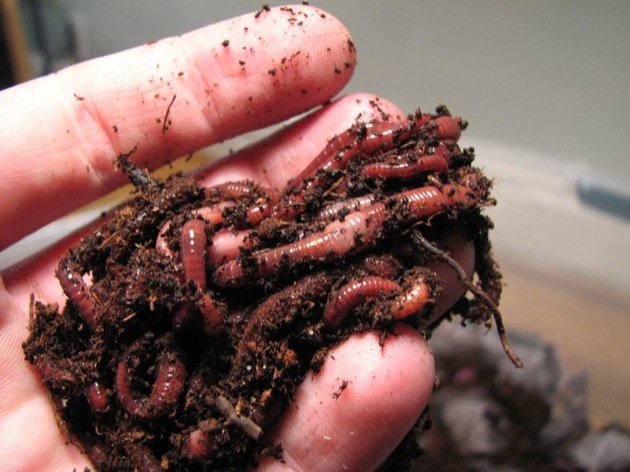
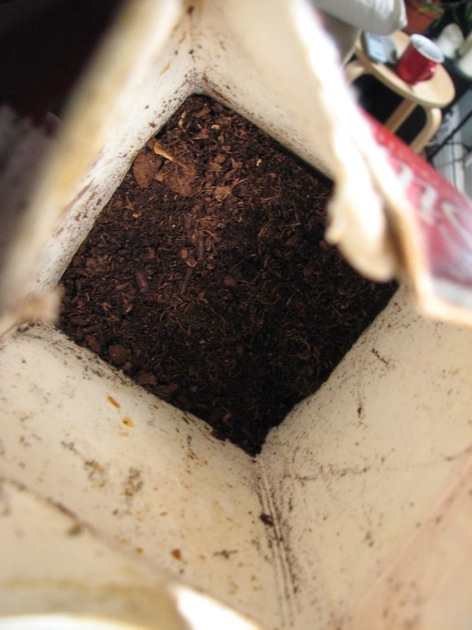
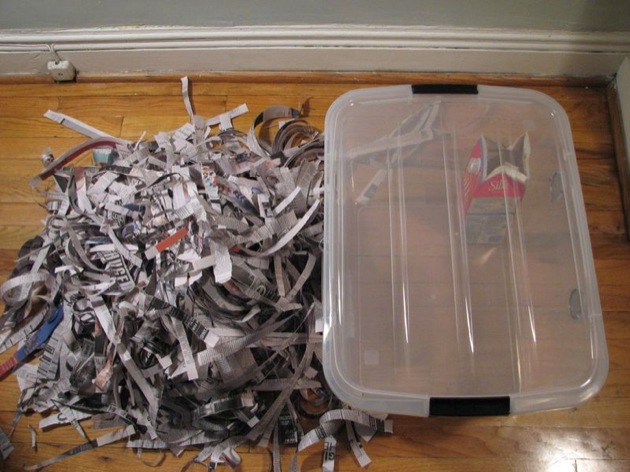
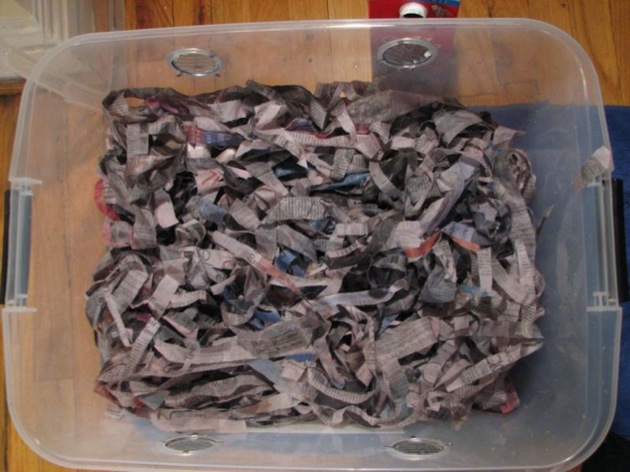
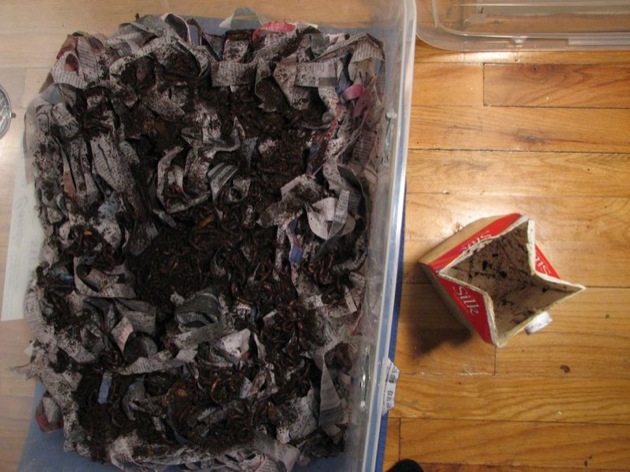
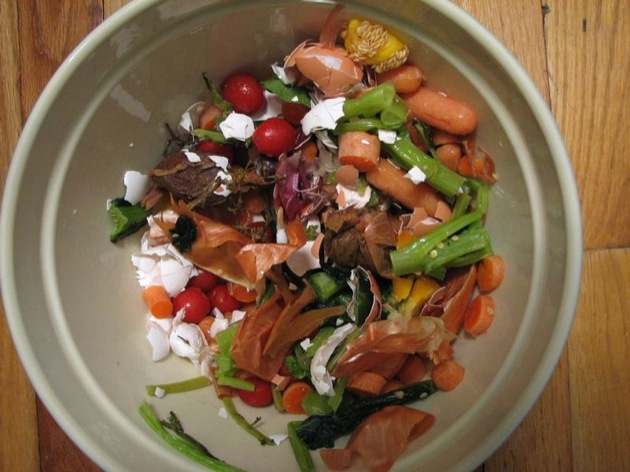
Comments:
Blog Comments powered by Disqus.